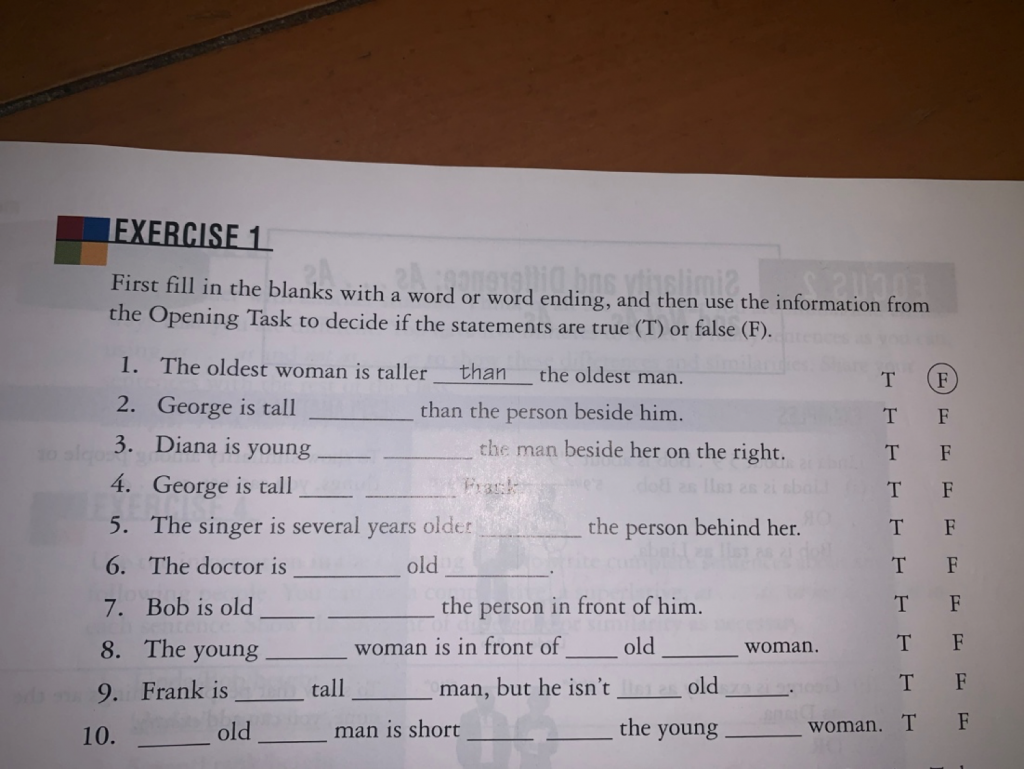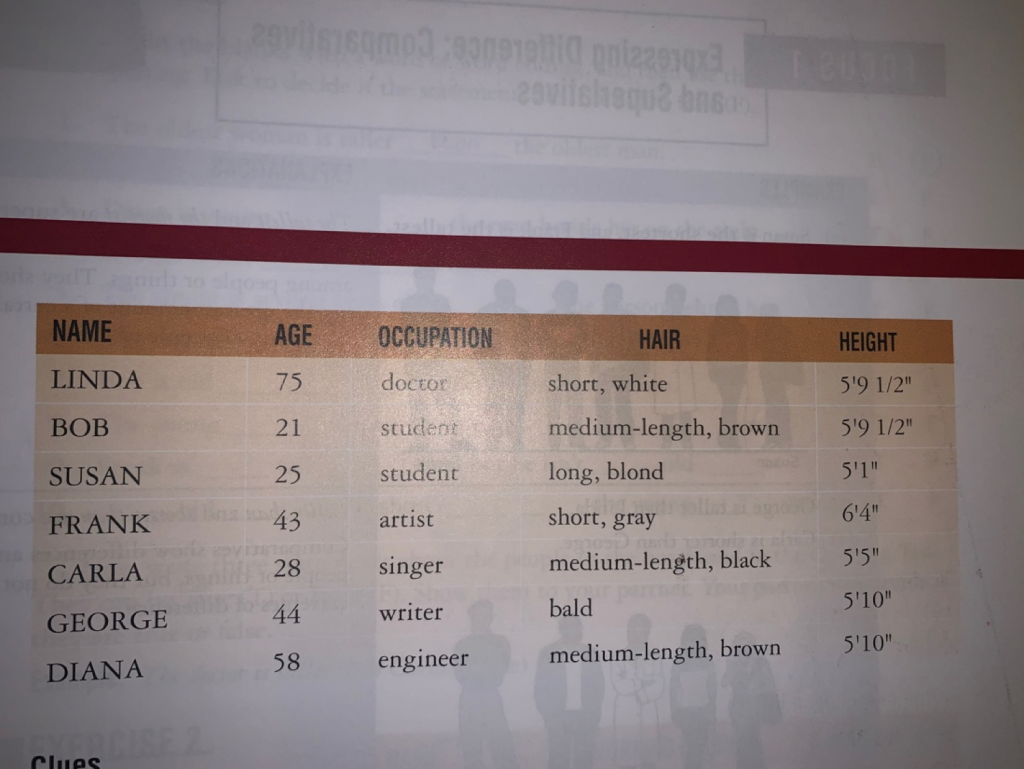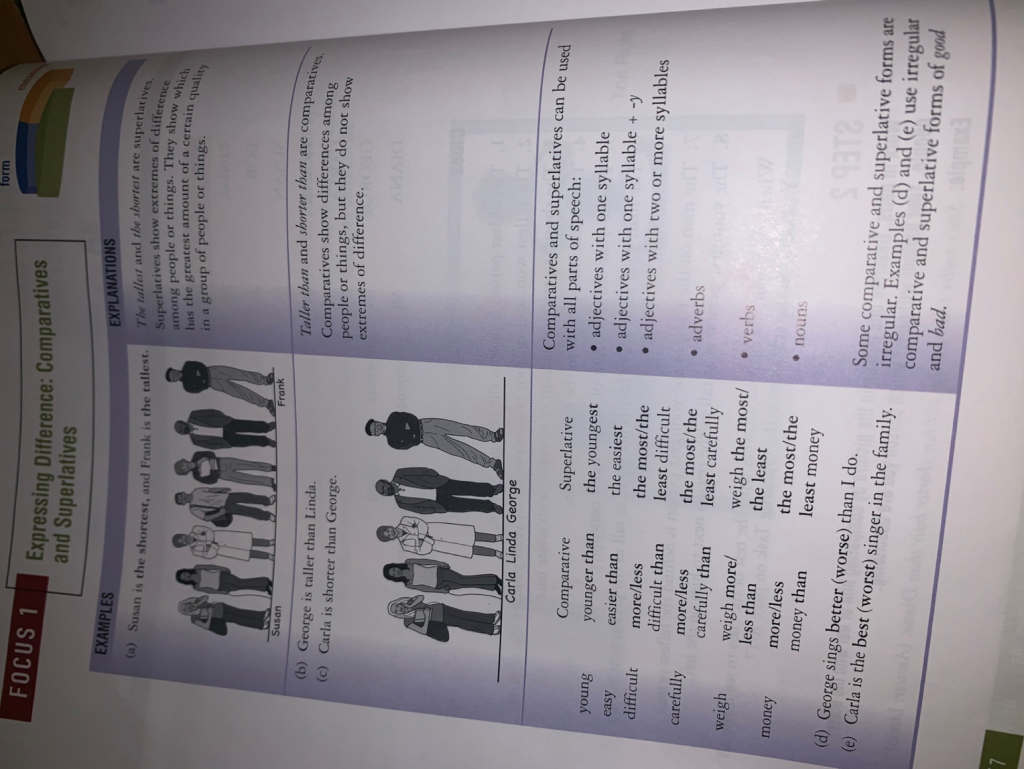Within my ESL text, Grammar Dimensions; Form, Meaning, and Use, activity 1 in chapter 7 is the exercise I believe needed the most improvement. This activity is meant for the student to fill in the blanks with a word or word ending then use the chart information from the Opening Task to state whether the statement was true or false. The chart in the opening tasks lists the height, age, and gender of different people. The language skill focused on in this exercise is using comparatives and superlatives. I rate this exercise a 2 out of 5 for difficulty. It is the first exercise in the chapter, so it is not intended to challenge the student to great extent. It is intended to get the student familiar with the grammatical component being taught in this chapter.
The strengths that this activity exemplified included common theme, problem solving, and it addressed grammatical rules. The exercise was based off of a chart that was used at the beginning of the chapter. This allows for the student to already have a sense of comfort when starting a new exercise, but still will be able to build different grammatical strengths. For this exercise, the student had to fill in the blank to make the sentence grammatically correct. This allows for the student to make a decision about which word and its prefix or suffix fits best within that sentence by using their skills learned for the specific chapter. This allows for the student to build onto their inventory of grammatical rules. The student must then choose if the sentence they have completed is true or false base off of the height/age chart from the beginning of the chapter. This shows the strength of enabling the student to use their deep knowledge to see if they have applied the rules of English grammar correctly.
Personally, I believe a weakness that this activity exemplified were that it was generally unclear. The directions stated that the student is intended to use the chart from the beginning to the chapter to make their inferences, however I was using different charts that weren’t at the beginning of the chapter when I was completing the exercise. The exercise was a compiled list of individuals with their names, heights, and ages, so when I was looking for the name from my sentence in the exercise, it was difficult to find the name that correctly corresponds within a chart. Second, there was no communicative aspect brought into this exercise. It is hard to an ESL learner to understand their target languages without having communication aspects build into their curriculum. This makes it hard for students to use their target language when they come in contact with a native speaker in real situations.
As a way of improving this exercise, I thought it would be beneficial to eliminate the fill in the blank portion of the exercise and make the students circle one of the given options to fit in the blank. For example, George is tall/taller/tallest than the person beside him. This will allow for the student to see all of the options in front of them and eliminate part of the confusion. Also, I would make the entire exercise only use one specific chart. I wouldn’t mind having it related to the opening exercises in the beginning of the chapter, like the original exercise, however I would only pull sentences and inferences from that chart. This would alleviate any confusion and give the students only one chart to base their decisions off of. The student will still have to use their deep knowledge to determine if the sentence content was true or false based off of the chart information presented. At the end of the exercise, I intend to incorporate some type of communicative aspect as well. Generally, I would like the students to all stand up in a line and create inferences using superlatives and comparatives based on their height and age. This would allow for the students to apply their knowledge to real life situations as well as teach them how to communicate using these new skills they are learning. Also, it adds versatility for the teacher to be able to include this communicative aspect or not. If the teacher feels it might be too overwhelming for the students, they can simply skip it and complete it later in the chapter.
I believe that clearing up the chart confusion for this exercise will promote great success for any student using this text. It would alleviate any hesitation or confusing that the student has while trying to decipher their sentences and rationale. Also, by bringing in the communicative aspect at the end, it provides the students with a way to interact with their peers while also applying their new knowledge as they learn it. If the student goes through learning ESL without interaction with others using the new language, it is going to be very hard for them to hold a conversation with a native speaker of the language. Getting the students adapted to verbally using their grammar skills will set them up for success in the future.



Then this is the chart that is next to the actual exercise that draws confusion (directly above)